






Eric Pountney, Telegraphist, and George Speechley, Signalman, both joined HMS Venomous
at Rosyth on the 31 July, the same day as its first wartime CO, Lt Cdr
Donald MacIntryre RN. Poultney must have used a tripod to
photograph himself in the W/T Office on Venomous and his fellow telegraphists off duty in the dim light of their Mess deck. He kept copies of signals received or sent during the evacuation of
the Welsh and Irish Guards from Boulogne on the 23 May 1940, one of the
most dramatic events described in A Hard Fought Ship, and during the first of five trips to evacuate the troops from the North Mole and beaches near Dunkirk
on the 31 May. They record events as they happened while the outcome
was still in doubt. You can link to these signals from the foot of this
page.
But
before the signals tell their story I have asked a Wireless
Telegraphist on a wartime destroyer to describe the use of telegraphy
and visual
signalling. Keith Burns (on right below) was nineteen when he joined the modern U Class destroyer, HMS Undaunted,
at Malta in September 1944 as a Wireless Telegraphy Operator. Its
Commanding Officer, Lt Cdr Angus A. Mackenzie RNR, had been "No 1" to
Lt Cdr John McBeath RN, the CO of HMS Venomous
at Boulogne and Dunkirk in 1940.
Keith
described to me in a series of
e-mails the work of the telegraphists aboard a wartime destroyer and
gave me a better understanding of the photographs and naval signals
brought home from the war by Eric Pountney.
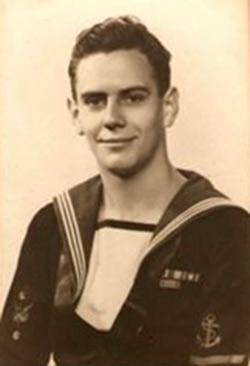
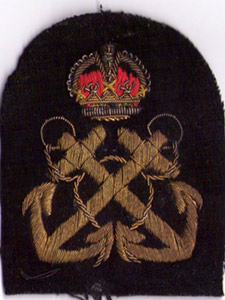 "It
took five months to train a Wireless Telegraphy Operator. They began by
learning Morse code and the navy's methods of sending and receiving
signals. To pass out at the end of the course they had to be able to
read at twenty-two words per minute and transmit at ten words per
minute. Telegraphists were also trained in coding since there were very few coders at the beginning of the war.
"It
took five months to train a Wireless Telegraphy Operator. They began by
learning Morse code and the navy's methods of sending and receiving
signals. To pass out at the end of the course they had to be able to
read at twenty-two words per minute and transmit at ten words per
minute. Telegraphists were also trained in coding since there were very few coders at the beginning of the war.
Once
completing training one became an Ordinary Telegraphist and advanced to
Telegraphist and Telegraphist (Trained Operator). Some ships had a
Leading Telegraphist and all destroyers would have a Petty Officer
Telegraphist. Flotilla Leaders would have a Chief Petty Officer.
Rates
were distinguished by the badge on their right arm. All Telegraphists
wore a badge with wings crossed by streak of lightning representing a
radio frequency pulse. Telegraphists (Trained Operators) wore
the same wing but above it was a star. Leading Telegraphists (W/T3)
wore the
wing with one star above and one star below and like all other Leading ratings, were entitled to wear an anchor, known as a 'killick', on the other
sleeve. This was known as 'Having picked up the hook'. The badges
(similar to an army corporal's 'stripes') on the left arm beneath the killick
were awarded
for good conduct., one after three years service, two after seven years
and three after twelve years. Keith
Burns was a Leading Telegraphist with one badge below the hook
(killick) on his left sleeve when this photograph was taken. A Petty
Officer Tel. would have a
crown above the wings and crossed anchors on the other arm (on left). The Chief
Petty Officer Telegraphist wore the wings on each collar of his jacket,
with a crown above, and a single star below but only after having had
the rate for a year.
The bulk of the signals were at relatively long range. Radio Silence was usually essential so they mainly came from shore bases. We sat in the W/T Office in front of a receiver and wore headphones while we read all the signals that were transmitted to ships in the part of the world in which we were operating. Separate sets were used for transmitting and receiving, the latter being smaller. Some of the signals were for the attention of all ships in that region and others for particular ship(s). The equipment in the photograph of photograph of the W/T Office on Venomous is very different from that on HMS Undaunted.
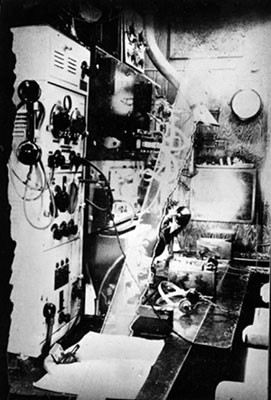
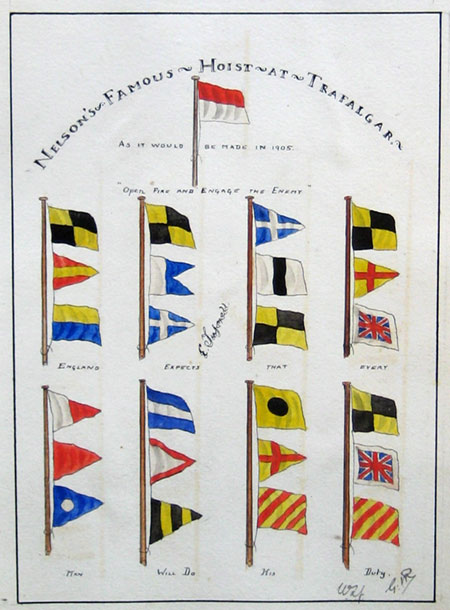 The signal had to be framed in a certain way beginning,
obviously, with the address. The address would be in letters and the
text in groups of four figures. Every
signal, even if it were for the same ship, would have a different
address and it would only become clear as to who it was for when the
address had been decoded. Ten signals, ten different addresses due to
the coding. I know it sounds double dutch but it was the sophistication of the coding.
The signal had to be framed in a certain way beginning,
obviously, with the address. The address would be in letters and the
text in groups of four figures. Every
signal, even if it were for the same ship, would have a different
address and it would only become clear as to who it was for when the
address had been decoded. Ten signals, ten different addresses due to
the coding. I know it sounds double dutch but it was the sophistication of the coding.
When the
address had been received and written on a message pad, we would let
the coder on watch see this and he would decode the address to see if
it concerned us. The key to the
code were the two identical five figure groups at the beginning and end
of the signal. I have always considered that it must have been
impossible to break the code but I don't know if the enemy ever managed
it. The coder would either decode the text
himself or if the security was above a certain level pass it to the
ship's Signals Officer for decoding.
All ships carried a Signals Officer and on destroyers this was often
the ship's Navigating Officer.
Petty Officer Telegraphists
sometimes insisted that the telegraphist reading the signal should read
it all even if we had no interest in it. This was seen as good practice
in developing one's skills.
These transmissions went on 24 hours each day and in the rare cases of
there being nothing to send, then the transmitter would repeat signals
sent earlier. These signals were known as "Routines" and it was usually
the job of the more junior ratings to read these. As a result they were
reading constantly during their watch. No let up. There were times when
signals were impossible to read due to atmospherics or other
conditions. Signals were consecutively numbered so we knew if something
had been missed. Some telegraphists were better at tuning a receiver
than others, a constant frustration. Unless engaged with the enemy radio
silence was essential to avoid giving away the position of the ship and for close range communication the visual signalman came into their own.
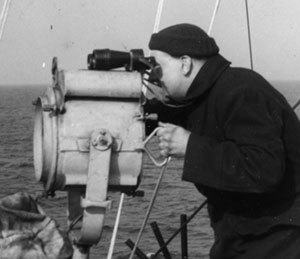 In 1905 Midshipman Eric E.C. Tufnell painted "Nelson's
Famous Hoist at Trafalgar" in his Midshipman's Log but at the Battle of Jutland signal flags
had been obscured by smoke from the funnels of the battleships.
"Bunting tossers" (Visual Signalmen) increasingly communicated with
other ships in company with flashing lights (in morse
but plain language, not coded). There were 20 inch and 10 inch
signalling lamps and smaller
hand held Aldis lamps. In clear weather the 20 inch lamp could
be read quite easily at 10 miles distance but lamps could only be used in
daylight.
After dark they would have been a security risk. Oscar Maylands is the man using the large lamp in the photograph. Flags were still used
for passing signals at close range but their use diminished as Radio
Telegraphy (for voice transmission) became more popular, particularly
amongst the huge fleet operating in the
Pacific. The same equipment was used for receiving and transmitting,
unlike W/T.
In 1905 Midshipman Eric E.C. Tufnell painted "Nelson's
Famous Hoist at Trafalgar" in his Midshipman's Log but at the Battle of Jutland signal flags
had been obscured by smoke from the funnels of the battleships.
"Bunting tossers" (Visual Signalmen) increasingly communicated with
other ships in company with flashing lights (in morse
but plain language, not coded). There were 20 inch and 10 inch
signalling lamps and smaller
hand held Aldis lamps. In clear weather the 20 inch lamp could
be read quite easily at 10 miles distance but lamps could only be used in
daylight.
After dark they would have been a security risk. Oscar Maylands is the man using the large lamp in the photograph. Flags were still used
for passing signals at close range but their use diminished as Radio
Telegraphy (for voice transmission) became more popular, particularly
amongst the huge fleet operating in the
Pacific. The same equipment was used for receiving and transmitting,
unlike W/T.
We had eleven telegraphists and two coders on HMS Undaunted
and I think that was fairly typical for destroyers. On our Mess we had
telegraphists, visual signalmen and coders but no RDF operators (they
were classed as seamen). Hammocks
were slung over the mess table but only after a certain time in the
evening. The long seat on which we sat at the table had a top which
could be lifted up and covered our lockers. The seat was topped with a
cushion and some ratings slept on this instead of slinging their
hammocks. One of the most popular places was on the table itself where
the person would lay his hammock.
Two telegraphists would be on watch together
in the W/T Office and there were, of course, four watches. I was interested to see the photo taken in the W/T Office on Venomous
and it looks as if it was even more cramped than ours. I did not
recognise any of the wireless sets. I guess they had all been
superceeded by my time.
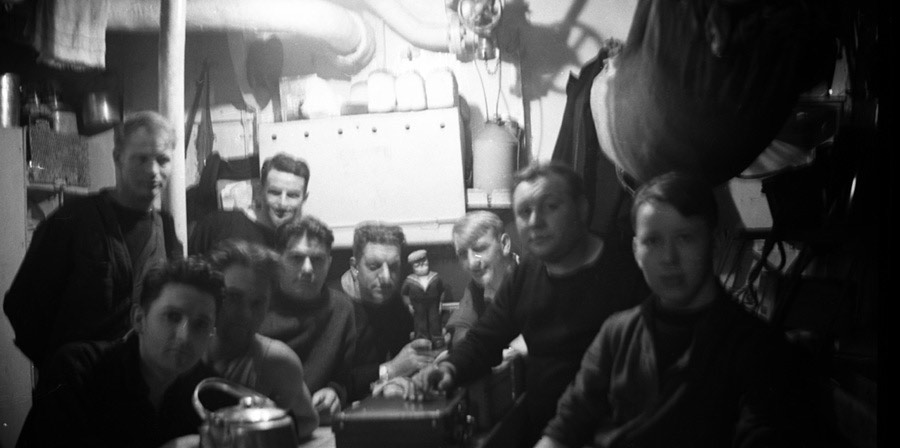
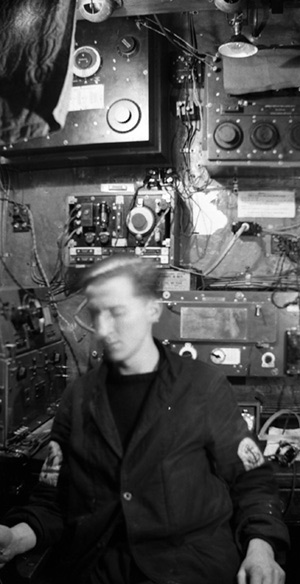
HMS Venomous was an elderly V&W Class destroyer built in 1919 and HMS Undaunted
was a modern newly built U Class destroyer. The equipment we used was
more advanced than that installed in HMS Venomous
when Eric Pountney (photographed below) joined it in August 1939.
Bill Legg, Curator of the Royal Navy Museum of Radar and
Communication describes the equipment used on Venomous at the bottom of
this page.
Procedures may also have changed
between1939 when Eric Pountney joined Venomous and 1944 when I joined Undaunted.
I think the signals he kept are copies, not originals, as they differ
from the standard practice for recording the Time of
Origin (TOO) in 1944. The time which we put on a
signal comprised the first two figures for the date and the next four
figures for the time (the month was not recorded) and then a letter which represented the time zone.
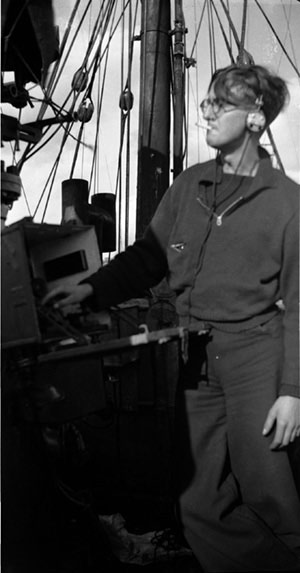

By the time I joined Undaunted there was one transmitting station (Whitehall) for the whole of the
Home and Atlantic Fleets, one for the Mediterranean Fleet, and a very
few others but surprisingly only one (Hawaii - Pearl Harbour) for the
entire Pacific.
The
Americans made their routine signals by machine which transmitted at
about 30 words per minute and when reading these it was totally
impossible to write quickly enough. All American telegraphists
(Radiomen) were trained to type so that when receiving speeds at this
rate they could type instead of writing. When the British Pacific Fleet
(BPF) was formed and we arrived in the Pacific, all our telegraphists had to
be trained in typing.
The Royal Navy was embarrassed that it could neither send of receive
Morse Code at the speed of the USN, which, months later, after VJ day
in August 1945, led to a complete rethink on training RN Telegraphists.
Towards
the end of the war Radio Telephone (R/T) came to be used between ships
in company and uncoded voice messages were transmitted. This was a
tremendous advantage to the fleet in company. It also relieved the
Signalmen of a lot of work much to the disgust of the telegraphists!
There were many ancillary matters covered by telegraphists such as the
technical aspects of the equipment, batteries etc.
A few telegraphists were trained as High
Frequency/Direction Finders (HF/DF, known as "huff-duff") to determine
the position of German U-boats and commerce raiders, but they only had
to carry out
these duties at specific times. At other times they had the normal
duties of "sparkers" which lightened the load on the mainstream telegraphists and we could switch to four watches instead of three.
I would like to finish by telling you a personal story. I was on watch in the W/T office during the middle of the night. Things were fairly quiet and I had turned the volume on my receiver to its highest level and then hung my headphones around my neck. Of course I fell asleep. Asleep on watch - was there a worse crime? Who should come into the office but our Signals Officer. Did he put me on a serious charge? No. He put his hand on my shoulder, I awoke and he said, 'Burns, one day someone will catch you asleep on watch.' Then without another word he walked out and the event was never mentioned again. I made sure it never reoccured and the officer's behaviour was a lesson to me in humanity which I was able to use in my own career, with my own staff. I told him this after the war."
Radio Telegraphy equipment on HMS Venomous
Bill Legg, the former Curator of The Royal Navy's Museum of Radar and Communication at Fareham, describes the equipment for receiving and transmitting telegraphy on HMS Venomous when Eric Pountney joined in August 1939 and later modifications:
"Venomous
went to war with archaic equipment installed in the late 1920s but was
still able to communicate with the shore and other Fleet Units at sea.
Visitors to the Royal Navy Museum of Radar and Communications can see a mockup of a 1920 period W/T Office. The receiver consisted of up to six separate parts, each bulkhead
mounted and interconnected. The transmitter, was similar but had fewer units married together. Venomous had
two quite separate areas devoted to wireless telegraphy, the
main operating area containing the receiver and associated equipment
and another for the high powered transmitter.
The Type 37S transmitter had been introduced in 1924 and last modified in 1930. The
"SPARK" waveform of the Type 37S was extremely dangerous
and unpredictable and in the past operators had received fatal electric
shocks and RF burns. The operator sat well away from the transmitter in
a 'cage' which in a small ship like Venomous was an integral part of the W/T office. The high powered transmitter was connected to the aerial on the
superstructure via metal trunkings which ran through the decks of the
ship, and this trunkings radiated dangerous RF voltages resulting in
very little of the power actually getting to the aerial - such were the
losses. Touching that trunking, or being thrown onto the trunking in
rough weather, was not recommended.
In
1942 following Japan's attack on Pearl Harbour and Germany's
declaration of war on America the US stepped up its assistance to
Britain, including the supply of modern radio communication equipment
to the Royal Navy. HMS Venomous may have been equipped with the new US supplied Type 60 transmitter or
one of its variants during its major refit in the first quarter of 1942
after its collision with HMS Keppel.
This transmitter was kept quite separate from the
receiver in the W/T Office and wired with coaxial cable direct to a
transformer which was directly connected/coupled to the intended
aerial. Thus, all the intended output power went into the ether and
personal shocks became a thing of the past. HMS Undaunted would have been fitted with the Type 60 transmitter when built."
From Morse Code to Modern Data Transmission
Morse Code required expert operators to intrepret the signals into
alpanumeric characters but eventually machines were developed which
de-skilled the task by allowing characters to be typed and printed
which could be used by low paid operators. Electro-mechanical machines
were replaced in the 1970's with computers, the 5 bit Baudot Code grew
into 7 bit ASCII code allowing 128 characters to be coded. Today ASCII
is replaced by Unicode, a 32 bit code which can encode every
characterof every language of the world, but the basic principles of
the modern Internet age are still those of Wheatstone and Morse. Wth
due acknowledgement to "Telegraphy: a brief history" by Trevor L Cass.
I shall end this page with another of Keith Burns' stories:
Eric Pountney kept copies of the naval signals received and sent by HMS Venomous during the evacuation of the Welsh and Irish Guards from Boulogne on the 23 May 1940 and on the 31 May when Venomous
made the first of five trips to evacuate the troops from Dunkirk. There
was no need to preserve radio silence as the destroyers were in close
contact with the enemy and their positions were known. Most of the
signals are from ship to shore where, Bertram Ramsay, Vice Admiral
Destroyers (VAD) was directing operations from Dover Castle. These
signals give a vivid impression of decisions being
made and sometimes reversed in response to rapidly changing events.
Follow events as they happened by reading the naval signals received and sent by HMS Venomous at
Boulogne on the 23 May 1940 and Dunkirk on the 31 May 1940
Eric Pountney was a keen photographer and his pictures tell the story of his wartime service